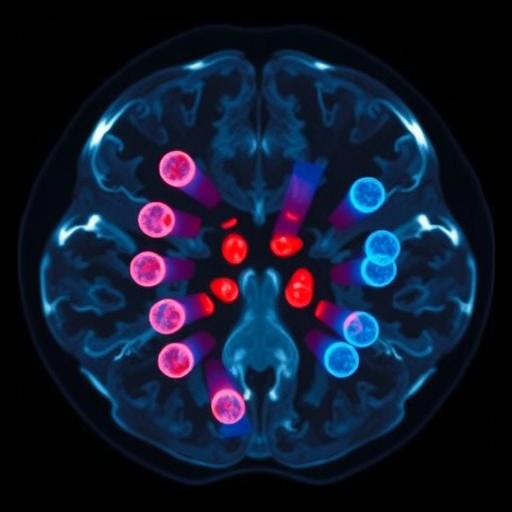A groundbreaking advance in regenerative medicine has emerged with the successful development and in vivo tracking of adipose-derived stem cell (ADSC) sheets cultivated on a biodegradable nonwoven fabric scaffold, as detailed in the recent study published in BioMedical Engineering OnLine. This innovative approach integrates cutting-edge biomaterial engineering with sophisticated imaging technology, providing a promising platform for safe and effective cellular transplantation therapies.
The research centers on a specially designed biodegradable nonwoven fabric, engineered not only to support the rapid extraction and culture of ADSCs directly from adipose tissue slices but also to facilitate the formation of thick, viable cell sheets without the need for enzymatic digestion. This represents a significant leap forward, eliminating complexities and potential cellular damage associated with traditional enzymatic isolation methods. The nonwoven fabric’s unique composition—incorporating 50% hydroxyapatite by weight—plays a crucial role, not only in supporting cell adhesion and proliferation but also enabling the cell sheet’s distinct visibility under X-ray computed tomography (CT) imaging.
The core innovation lies in the material selection and fabrication of the nonwoven fabric scaffold. Hydroxyapatite, a naturally occurring mineral form of calcium phosphate, is integrated to enhance biocompatibility and act as a contrast agent for X-ray imaging. This dual functionality ensures that once transplanted, the cell sheets can be non-invasively monitored in vivo over extended periods, a feature that addresses a persistent challenge in regenerative therapy: the ability to track graft survival, integration, and biodegradation within the host tissue.
In the conducted animal experiments, the thick ADSC sheets, supported by two layers of this biodegradable nonwoven fabric, were delicately sized and transplanted into the buccal region of rats. Throughout the 12-week observation period, meticulous health monitoring revealed no adverse effects attributable to the implant, aside from one instance suggestive of surgical complications rather than material toxicity or immune rejection. This finding underscores the scaffold’s biocompatibility and the safety profile of the transplantation procedure.
Advancing beyond mere survival, the study demonstrated the real-time observation of the implanted cell sheets using X-ray CT imaging. The high mineral content of the hydroxyapatite-enhanced scaffold permitted clear visualization of the implant’s contour, position, and morphology as it biodegraded gradually over the 12 weeks inside the living organism. Such precise, longitudinal tracking represents an unprecedented capacity in non-invasive in vivo stem cell therapy monitoring, illuminating the dynamic interaction between transplanted cells and host tissues.
The degradation process of the scaffold, an essential parameter in tissue engineering, was effectively documented through sequential CT scans. The nonwoven fabric’s biodegradation closely matched the anticipated timeline, ensuring that the scaffold provided structural support during critical early engraftment phases, then safely resorbed as native tissue remodeled and integrated. This controlled degradation mitigates risks associated with permanent implants such as chronic inflammation or fibrotic encapsulation.
This technological milestone doubles as a powerful platform to evaluate cell sheet behavior post-transplantation. Changes in sheet shape and size correlated with biological integration and cellular remodeling events, information previously difficult to acquire without invasive biopsies or complex labeling strategies. The ability to observe these parameters non-invasively promises to refine therapeutic protocols and improve outcomes by facilitating personalized adjustments during treatment.
The ease of producing thick ADSC sheets was another highlight of this work. Unlike cell sheets requiring complex detachment procedures, the current approach allows direct seeding of adipose tissue slices onto the nonwoven scaffold, leading to rapid and reproducible sheet formation. This reduces time and labor-intensive steps while preserving cell viability and function, factors crucial for translating laboratory findings into clinical practice.
Further, the study’s implications extend to the broader field of regenerative medicine. The biodegradable nonwoven scaffold’s dual role—as a cell carrier promoting engraftment and as an in vivo imaging substrate—may catalyze the development of next-generation transplantation devices. Such devices are pivotal for regenerative therapies targeting diverse tissues where ensuring cell survival and monitoring post-transplant progression are critical.
The integration of biomaterial science and imaging technology exemplified in this research effectively addresses major hurdles in regenerative therapy. By utilizing a smart scaffold designed for biodegradability and visibility under standard X-ray CT, the scientists have established a platform conducive to real-time clinical monitoring, a feature that can dramatically enhance patient safety and therapeutic efficacy.
This advancement opens avenues for personalized medicine, where transplanted cell sheets can be tailored in shape and size to fit affected areas and their integration progress can be observed non-invasively over clinically relevant timescales. This continual feedback loop is invaluable for refining implant techniques, assessing therapeutic success, and making adjustments promptly.
In conclusion, the study conclusively validates the use of hydroxyapatite-laden biodegradable nonwoven fabrics as safe, effective carriers for adipose-derived stem cell sheets. Their compatibility with X-ray CT imaging provides an essential tool for clinicians and researchers alike, facilitating in vivo observation and tracking of cell transplantation in real-time. This innovation sets the stage for enhanced regenerative treatments that are both safe and precisely monitored, promising transformative impacts on patient care and recovery trajectories.
As regenerative medicine continues to evolve, the convergence of biomaterial innovation and advanced imaging techniques embodied in this work is poised to become a cornerstone of future therapeutic modalities. The demonstrated feasibility and benefits of this transplantation device may well accelerate the translation of stem cell therapies from bench to bedside, enriching the armamentarium against tissue damage and degenerative diseases.
This research heralds a new era in which complex tissue engineering constructs are no longer “black boxes” once implanted but dynamically visible and manageable entities within the living body. The ability to non-invasively monitor the fate of transplanted cells revolutionizes healing paradigms and cultivates hope for more effective regenerative interventions worldwide.
Subject of Research: Adipose-derived stem cell sheets on biodegradable nonwoven fabric scaffolds and their in vivo imaging using X-ray computed tomography.
Article Title: In vivo imaging of adipose-derived stem cell sheets on biodegradable nonwoven fabric using X-ray CT.
Article References: Sunami, H., Shimizu, Y., Nakasone, H. et al. In vivo imaging of adipose-derived stem cell sheets on biodegradable nonwoven fabric using X-ray CT. BioMed Eng OnLine 23, 133 (2024). https://doi.org/10.1186/s12938-024-01324-x
Image Credits: AI Generated




